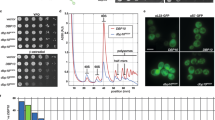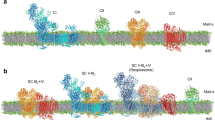Abstract
The mitochondrial inner membrane peptidase IMP of Saccharomyces cerevisiae is required for proteolytic processing of certain mitochondrially and nucleus-encoded proteins during their export from the matrix into the inner membrane or the intermembrane space. The membrane-associated signal peptidase complex is composed of the two catalytic subunits, Imp1 and Imp2, and the Som1 protein. The IMP subunits are thought to function in membrane association, interaction and stabilisation of subunits, substrate specificity, and proteolysis. We have analysed inner membrane peptidase mutants and substrates to gain more insight into the functions of various domains and investigate the basis of substrate recognition. The results suggest that certain conserved glycine residues in the second and third conserved regions of Imp1 and Imp2 are important for stabilisation of the Imp complex and for the proteolytic activity of the subunits, respectively. The non-conserved C-terminal parts of the Imp subunits are important for their proteolytic activities. The C-terminal region of Imp2, comprising a predicted second transmembrane segment, is dispensable for the stability of Imp2 and Imp1, and cannot functionally substitute for the C-terminal segment of Imp1. Alteration of the Imp2 cleavage site in cytochrome c 1 (from A↓M to N↓D) reveals the specificity of the Imp2 peptidase. In addition, we have identified Gut2, the mitochondrial FAD-dependent glycerol-3-phosphate dehydrogenase, as a new substrate for Imp1. Failure to cleave the Gut2 precursor may contribute to the pet phenotype of certain imp mutants. Gut2 is associated with the inner membrane, and is essential for growth on glycerol-containing medium. Suggested functions of the analysed residues and domains of the IMP subunits, characteristics of the cleavage sites of substrates and implications for the phenotypes of imp mutants are discussed.





Similar content being viewed by others
References
Arnold I, Pfeiffer K, Neupert W, Stuart RA, Schägger H (1999) ATP synthase of yeast mitochondria. Isolation of subunit j and disruption of the ATP18 gene. J Biol Chem 274:36–40
Bauerfeind M, Esser K, Michaelis G (1998) The Saccharomyces cerevisiae SOM1 gene: heterologous complementation studies, homologues in other organisims and association of the gene product with the inner mitochondrial membrane. Mol Gen Genet 257:635–640
Behrens M, Michaelis G, Pratje E (1991) Mitochondrial inner membrane protease 1 of Saccharomyces cerevisiae shows sequence similarity to the Escherichia coli leader peptidase. Mol Gen Genet 228:167–176
Bolivar F, Rodriguez RL, Green PJ, Betlach MC, Heyneker HL, Boyer HW, Crosa JH, Falkow S (1977) Construction and characterization of new cloning vehicles. Gene 2:95–113
Brachmann CB, Davies A, Cost GJ, Caputo E, Li J, Hieter P, Boeke JD (1998) Designer deletion strains derived from Saccharomyces cerevisiae S288C: a useful set of strains and plasmids for PCR-mediated gene disruption and other applications. Yeast 14:115–132
Broadley SA, Demlow CM, Fox TD (2001) Peripheral mitochondrial inner membrane protein, Mss2p, required for export of the mitochondrially coded Cox2p C tail in Saccharomyces cerevisiae. Mol Cell Biol 21:7663–7672
Capaldi RA, Malatesta F, Darley-Usmar VM (1983) Structure of cytochrome c oxidase. Biochim Biophys Acta 726:135–148
Chen X, Van Valkenburgh C, Fang H, Green N (1999) Signal peptides having standard and nonstandard cleavage sites can be processed by Imp1p of the mitochondrial inner membrane protease. J Biol Chem 274:37750–37754
Dalbey RE, Lively MO, Bron S, van Dijl JM (1997) The chemistry and enzymology of the type I signal peptidases. Protein Sci 6:1129–1138
Esser K, Pratje E, Michaelis G (1996) SOM1, a small new gene required for mitochondrial inner membrane peptidase function in Saccharomyces cerevisiae. Mol Gen Genet 252:437–445
Esser K, Scholle B, Michaelis G (1999) Disruption of six open reading frames on chromosome X of Saccharomyces cerevisiae reveals a cluster of four essential genes. Yeast 15:921–933
Gasser SM, Ohashi A, Daum G, Böhni PC, Gibson J, Reid GA, Yonetani T, Schatz G (1982) Imported mitochondrial proteins cytochrome b2 and cytochrome c1 are processed in two steps. Proc Natl Acad Sci USA 79:267–271
Gietz RD, Schiestl RH, Willems AR, Woods RA (1995) Studies on the transformation of intact yeast cells by the LiAc/SS-DNA/PEG procedure. Yeast 11:355–360
Hahne K, Haucke V, Ramage L, Schatz G (1994) One gene encodes two isoforms of NADH-cytochrome b5 reductase in different mitochondrial subcompartments. Cell 79:829–839
Hanahan D (1983) Studies on transformation of Escherichia coli with plasmids. J Mol Biol 166:557–580
Hell K, Herrmann JM, Pratje E, Neupert W, Stuart RA (1998) Oxa1p, an essential component of the N-tail protein export machinery in mitochondria. Proc Natl Acad Sci USA 95:2250–2255
Hill JE, Myers AM, Koerner TJ, Tzagoloff A (1986) Yeast/ E. coli shuttle vectors with multiple unique restriction sites. Yeast 2:163–167
Innis MA, Gelfand DH, Sninsky JJ, White TJ (eds) (1990) PCR protocols: a guide to methods and applications. Academic Press, San Diego
Jan PS, Esser K, Pratje E, Michaelis G (2000) Som1, a third component of the yeast mitochondrial inner membrane peptidase complex that contains Imp1 and Imp2. Mol Gen Genet 263:483–491
Luo W, Chen X, Fang H, Green N (2003) Factors governing nonoverlapping substrate specificity by mitochondrial inner membrane peptidase. J Biol Chem 278:4943–4948
Meyer W, Bömer U, Pratje E (1997) Mitochondrial inner membrane-bound Pet1402 protein is rapidly imported into mitochondria and affects the integrity of the cytochrome oxidase and ubiquinol-cytochrome c oxidoreductase complexes. Biol Chem 378:1373–1379
Michaelis G, Mannhaupt G, Pratje E, Fischer E, Naggert J, Schweizer E (1982) Mitochondrial translation products in nuclear respiration-deficient pet mutants of Saccharomyces cerevisiae. In: Slonimski PP, Borst P, Attardi G (eds) Mitochondrial genes. Cold Spring Harbor Laboratory, Cold Spring Harbor, New York, pp 311–321
Nasmyth KA, Reed SI (1980) Isolation of genes by complementation in yeast: molecular cloning of a cell cycle gene. Proc Natl Acad Sci USA 77:2119–2123
Nunnari J, Fox TD, Walter PA (1993) A mitochondrial protease with two catalytic subunits of nonoverlapping specificities. Science 262:1997–2004
Pratje E, Guiard B (1986) One nuclear gene controls the removal of transient pre-sequences from two yeast proteins: one encoded by the nuclear, the other by the mitochondrial genome. EMBO J 5:1313–1317
Pratje E, Michaelis G (1977) Allelism studies of mitochondrial mutants resistant to antimycin A or funiculosin in Saccharomyces cerevisiae. Mol Gen Genet 152:167–174
Pratje E, Mannhaupt G, Michaelis G, Beyreuter K (1983) A nuclear mutation prevents processing of a mitochondrially encoded membrane protein in Saccharomyces cerevisiae. EMBO J 2:1049–1054
Riesmeier JW, Hirner B, Frommer WB (1993) Potato sucrose transporter expression in minor veins indicates a role in phloem loading. Plant Cell 11:1591–1598
Ronnow B, Kielland-Brandt MC (1993) GUT2, a gene for mitochondrial glycerol 3-phosphate dehydrogenase of Saccharomyces cerevisiae. Yeast 9:1121–1130
Rothstein RJ (1983) One-step gene disruption in yeast. Meth. Enzymol. 101:202–211
Sambrook J, Fritsch EF, Maniatis T (1989) Molecular cloning: a laboratory manual (2nd edn). Cold Spring Harbor Laboratory Press, Cold Spring Harbor, N.Y.
Schneider A, Behrens M, Scherer P, Pratje E, Michaelis G, Schatz G (1991) Inner membrane protease I, an enzyme mediating intramitochondrial protein sorting in yeast. EMBO J 10:247–254
Tjalsma H, Stover AG, Driks A, Venema G, Bron S, van Dijl JM (2000) Conserved serine and histidine residues are critical for activity of the ER-type signal peptidase SipW of Bacillus subtilis. J Biol Chem. 275:25102–25108
Tschantz WR, Sung M, Delgado-Partin VM, Dalbey RE (1993) A serine and a lysine residue implicated in the catalytic mechanism of the Escherichia coli leader peptidase. J Biol Chem 268:27349–27354
Van Dijl JM, de Jong A, Vehmaanpera J, Venema G, Bron S (1992) Signal peptidase I of Bacillus subtilis: patterns of conserved amino acids in prokaryotic and eukaryotic type I signal peptidases. EMBO J 11:2819–2828
Van Dijl JM, de Jong A, Venema G, Bron S (1995) Identification of the potential active site of the signal peptidase SipS of Bacillus subtilis. Structural and functional similarities with LexA-like proteases. J Biol Chem 270:3611–3618
Von Heijne G (1986) A new method for predicting signal sequence cleavage sites. Nucleic Acids Res 14:4683–4690
Winston F, Dollard C, Ricupero-Hovasse SL (1995) Construction of a set of convenient Saccharomyces cerevisiae strains that are isogenic to S288C. Yeast 11:53–55
Yaffe MP, Schatz G (1984) Two nuclear mutations that block mitochondrial protein import in yeast. Proc Natl Acad Sci USA 81:4819–4823
Yanisch-Perron C, Vieira J, Messing J (1985) Improved M13 phage cloning vectors and host strains: nucleotide sequence of the M13mp18 and pUC vectors. Gene 33:103–119
Acknowledgements
We thank Diana Smarandache for initial cloning experiments, Barbara Schumacher for careful technical assistance, and Drs. G. Schatz, B. Guiard and H. Weiss for providing antisera against Imp1, Cytb2 and Cytc1, respectively.
Author information
Authors and Affiliations
Corresponding author
Additional information
Communicated by C. P. Hollenberg
Rights and permissions
About this article
Cite this article
Esser, K., Jan, PS., Pratje, E. et al. The mitochondrial IMP peptidase of yeast: functional analysis of domains and identification of Gut2 as a new natural substrate. Mol Genet Genomics 271, 616–626 (2004). https://doi.org/10.1007/s00438-004-1011-y
Received:
Accepted:
Published:
Issue Date:
DOI: https://doi.org/10.1007/s00438-004-1011-y




